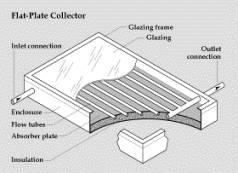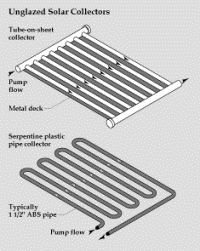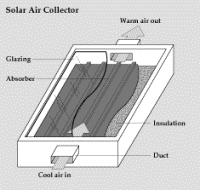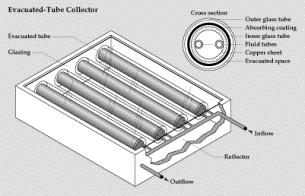|
A Solar Heating System can heat your water, pool, and rooms in your home!Here you will learn how a solar heating system harnesses the Free abundant power of the sun to run your solar hot water heater, solar swimming pool heater and provide solar space heating. The need for utilizing natural resources continues to escalate as our other forms of energy begin to plummet. Today architects are aware of this fact, and they too contribute by designing structures in a way that can be recognized for solar energy. Many buildings and homes are being designed so the natural rays of sunlight will heat the building passively. The south side of the building is typically lined with large panes of glass that will allow the rays to enter in and be absorbed by the flooring and walls. This is referred to as passive solar heating. You may have noticed on the roofs of homes what appears to be some sort of skylight. In actuality, this is a flat-plate collector. (A solar heater)
In The Solar Heating System, There are different types of Solar Collectors:
Their main purpose is to collect the sun’s energy, and then convert it into a solar thermal energy that allow us to heat our water in the home, our swimming pools, and even the rooms of the house naturally. Lets look at each and how they operate:
Flat Plate Collectors These are the most common collectors used for homes and they are primarily used for your solar hot water heater or for solar space heating.
A typical flat plate collector has an insulated metal box around the outside with a glass or plastic cover, (called glazing) and a dark colored absorber plate. These collectors heat liquid or air at temperatures less than 180 degrees.
Liquid Flat Plate Collectors These heat liquid as it flows through tubes in or around the absorber plate. These most basic systems heat the water as it passes through the collector and then flows into the house. Solar swimming pool heaters also use the liquid flat plate collector system, although these are typically unglazed. (without a glass or plastic cover)
Air Flat Plate Collector These are used primarily for solar space heating. The absorber plates can be metal sheets,layers of screen, or a non-metallic materials. The air flows past the absorber by using natural convection or a fan. Air conducts heat less efficiently than liquid does, so there is less heat generated by the air plate collector than the liquid plate collector.
Evacuated Tube Collector These can achieve extremely high temperatures (170- 350 degrees) making them better for cooling applications and commercial and industrial needs. These cost about twice as much as a regular flat plate collector.
Integral Collector Storage Systems These are also known as batch systems and are made of one or more black tanks in an insulated glazed box. (with glass or plastic covering) First cold water passes through the system and heats the water, it then continues on to the water heater. These systems are very simple and reliable but should be used in climates with milder temperatures as the pipes can freeze in severely cold weather. One benefit of using solar heating systems and a solar hot water heater is that we are able to conserve the resources that we have become reliant on. Of course, it is great to contribute to the conservation of the earth and its resources, but these systems are also very cost efficient. By utilizing one of these systems as opposed to relying on the electric company, you will notice a definite change for the better in your monthly bill.
To learn more about how a specific solar heating system can benefit you, check out one of the pages below.
Solar Hot Water Heaters
|









